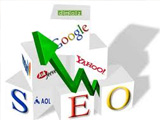|
|
TODAY.AZ / SEO & E-Marketing
Content Optimization Tutorial: How to SEO your Content for Rankings
28 July 2011 [16:30] - TODAY.AZ
 A lot of people have trouble figuring out the "correct" way to optimize content for keywords. Copywriters are resistant to having to use particular words to get their point across and, rightfully, don't want their content cluttered with dumb sounding "keyword" phrases.
A lot of people have trouble figuring out the "correct" way to optimize content for keywords. Copywriters are resistant to having to use particular words to get their point across and, rightfully, don't want their content cluttered with dumb sounding "keyword" phrases.It's unfortunate that "optimized content" has somehow come to mean something other than "marketing content" for a website.
Optimizing content for search engine rankings is first and foremost writing marketing copy for your visitors. The key difference is we know what (key) words your visitors are looking for, and it's just a matter of crafting the content to accommodate their interests.
When optimizing a page, we generally like to have something to work with. Most clients provide us some initial verbiage to use as a starting point. This information can help us better understand the client's perspective on their products or services and is an excellent resource for the finalized product.
Of course, this is only one resource. We also like to have a good understanding of the client's philosophies, hot points, key selling propositions, etc. All these get worked into the content as needed.
Keep Your Focus on Keywords
While optimized content is primarily sales and marketing driven, it must also use the keywords that searchers are using to find your products or services. There are three different types of "keywords" we try to work into every optimized page: core terms, supporting words, and related words.
Core Terms
Core terms are generally the subject of a page. A core term is a two, sometimes three-word phrase that summarizes what that page is focused on. All other phrases will be based on this primary phrase.
Examples:
* motorcycle battery
* dog collar
* plastic card
* kids clothes
Supporting Phrases
Supporting phrases are essentially the core term plus one or two other "qualifying words" that create a unique phrase. Generally, any single core term can have 100-1000 supporting phrases, but we like to focus a page on 10-20 of these phrases that are tightly related to each other.
Examples:
* motorcycle battery charger
* bark control dog collar
* plastic business card manufacturer
* kids ski clothes
These additional supporting words (charger, bark control, business, ski) can be used liberally within the content (keeping quality a priority). They do not necessarily need to be used within the full phrase, but should be when possible and it makes sense to do so. The key is to make sure these words are used on the page in some form or another.
Related Words
Related words are words and phrases that are generally found on pages focused on this particular topic. They may or may not be words people are typically searching, and they are definitely not words we are trying to rank for with this page, but they provide the reader (and search engine) greater context regarding the topic of the page.
Examples:
* motorcycle battery chargers
* bark control dog collars
* plastic business card manufacturing
* kids ski clothing
Related words might include stemmed variations of the core term (i.e., if the core term is "run," then stemmed variations might be: running and ran). But they are not always words that can be worked into the target phrase.
Look for words with similar meaning as the core term (jog, walk, hike, stroll) or words most often used in conjunction with the core terms (shoes, fast, sweat, exercise, hide, hydrate, etc). Not all related words will be relevant for a particular page. The writer should pick and choose related words to be used within the proper context.
It is important for all core, supporting and related words be carefully considered before optimizing a page. Core terms are the most important terms on each page and should be used as a phrase as often as good, readable copy allows.
Pay Attention to Writing Style
While keywords must be considered an important aspect of each optimized page, the ability to produce content with a natural style of writing and a focus on the marketing goals trumps all else. The content should use customer-focused language which speaks to the visitor's needs, providing solutions and organized in a manner that makes reading, skimming, clicking and purchasing easier.
Sales Message: Each page must have a clear sales message that entices the visitor to continue reading, offering easy click-access deeper into the site and ultimately into the final conversion. The writer must research both the company and the product or services being sold in order to deliver that message and provide enough information to help users make an informed decision about what they want.
Headings: Page and paragraph headings should be used wherever appropriate. Every page must have a page heading which succinctly introduces the content on the page. Headings should be matter-of-fact and, if it makes sense, use the core term (i.e. Expert PC Repair and Computer Networking Solutions).
Bullet Points: Certain paragraphs can often be broken down into bulleted lists for easy reading and scanning. This is a great way to get readers to find the benefits of a product or service quickly without reading a lot of the other text. Bullets help break up a redundant text page while making skimming and scanning easier.
Bolds and Italics: Bolded and italicize words should be used infrequently and only in ways which help the overall readability of the page. Skim- and scan-ability can be improved with selective bold and italic usage of important information. Don't only bold or italicize keywords, but rather phrases that contain key takeaways.
Internal Hyperlinks: When writing each optimized page, look for opportunities to link out to other pages of the website, or in some cases, external resources. Linked text should be absolutely relevant to the topic and link to pages that give greater detail or more information that can't be worked into that page. Links to 'about us,' 'contact us,' and products/service pages can be used liberally, as good writing and usability allows.
Calls to Action: A page without a call to action is a page wasted. The goal of every optimized page is to get the reader to take an action. Whether that action is to read more, find out how, download, purchase or to get additional information, the call to action is necessary to propel the visitor forward toward those goals.
Write Strong Page Titles and Descriptions
Each optimized page must have both a title and description (for HTML title and meta description tags), which are separate from the visible body content. Titles and descriptions are most often seen in search engine results and are primarily responsible for driving the click from the search result to the optimized page.
Titles: The "title" of every optimized page is probably the single most important place to optimize. The title should be 8-12 words in length and contain the core term.
Since the title is the clickable link in the search results, it must provide value to searchers so that they will be compelled to click into to the site. Titles should never be deceptive or provide information that is not found in the body content of the page.
Descriptions: Also used in the search results, page descriptions need to provide additional, relevant information that can't fit into the title. Both core and supporting keywords should be used in the description, giving the searcher as much information as possible in a very short and succinct paragraph. Description should be 30-50 words in length.
Putting all of these components together can give you a very strong, well-crafted, optimized page that will perform well for both search engines and visitors alike. Getting keyword rankings isn't good enough. The page must generate profits! Any page can get traffic. An optimized page should draw traffic through rankings and be a critical part of the conversion/persuasion process.
/Search Engine Guide/
URL: http://www.today.az/news/seo/91612.html
 Print version
Print version
Views: 2508
Connect with us. Get latest news and updates.
See Also
- 02 March 2025 [21:33]
Xiaomi unveils Hyper AI techonology - 07 January 2025 [16:17]
Azerbaijani IT Institute discusses cybersecurity for drones - 02 December 2024 [19:10]
AZAL continues to offer discounts with Cyber Monday campaign - 29 November 2024 [16:49]
Jury composition for CINEMO Int'l Mobile Film Festival announced - 09 November 2024 [15:00]
Bitcoin price hits record high following Trump's win - 05 November 2024 [12:21]
Submissions for CINEMO Int'l Mobile Film Festival wraps up - 25 October 2024 [11:57]
SIMA Imza named best Biometric Digital Signature of year by Global Economics - 12 October 2024 [15:46]
Cyber attacks on Azerbaijan’s state institutions announced - 05 October 2024 [08:00]
Jabrayil City Day celebrated with festivities - 04 October 2024 [09:00]
Open AI company, which developed AI chatbot attracted $6.6 billion in investments
Most Popular
 Microsoft to develop AI in Hungarian
Microsoft to develop AI in Hungarian
 President of Azerbaijan Ilham Aliyev receives Italian delegation led by Minister for Enterprises and Made in Italy in Mingachevir
President of Azerbaijan Ilham Aliyev receives Italian delegation led by Minister for Enterprises and Made in Italy in Mingachevir
 40 kilometers that could save Armenia
40 kilometers that could save Armenia
 Tourism Bureau: Cooperation with Azerbaijan Railways to boost regional travel
Tourism Bureau: Cooperation with Azerbaijan Railways to boost regional travel
 Azerbaijani Foreign Ministry welcomes Israel-Iran ceasefire
Azerbaijani Foreign Ministry welcomes Israel-Iran ceasefire
 Work nears completion on Yevlakh section of Baku-Alat-Gazakh-Georgia highway
Work nears completion on Yevlakh section of Baku-Alat-Gazakh-Georgia highway
 President Ilham Aliyev received Chairman of the Board of China’s Dongfang Electric International Corporation in Mingachevir
President Ilham Aliyev received Chairman of the Board of China’s Dongfang Electric International Corporation in Mingachevir
